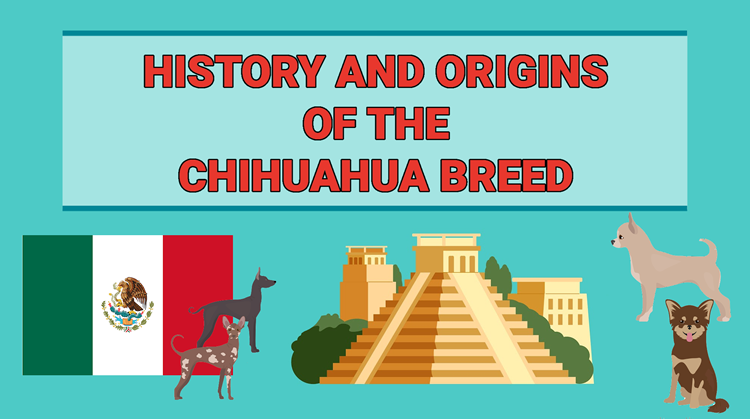
Like many modern-day dog breeds, much of the Chihuahua’s history is shrouded in mystery.
Where did the Chihuahua originate from? Were they brought over from Europe? Are they descendants of a different breed? Were they bred for a specific purpose like hunting rodents or herding livestock? While there’s no definitive answer to these questions, historians have concocted several theories on the Chihuahua’s history that we’re going to explore.
The State of Chihuahua, Mexico
Historians continue to speculate on the Chihuahua’s true origins, but most agree that it leads back to the state of Chihuahua Mexico. Spanning 95,544 mi² (247,460 km2) and bordering Texas and New Mexico to the northeast (see map below), Chihuahua is a the largest of Mexico’s 32 states. It was here where dog fanciers are believed to have discovered some of the earliest Chihuahua specimens in the mid-1800s.
In 1884, Mexican merchants began selling the small dog to border tourists, many of whom brought them back to the U.S. to keep as pets. Back then, the dog didn’t have an official name. Rather, people named it after the region in which it was seen. This resulted in the modern-day Chihuahua being called the Arizona dog, Texas dog, Mexico dog, and the Chihuahua dog. Of course, only one of these names withstood the hands of time, with the breed now being universally recognized as the Chihuahua.
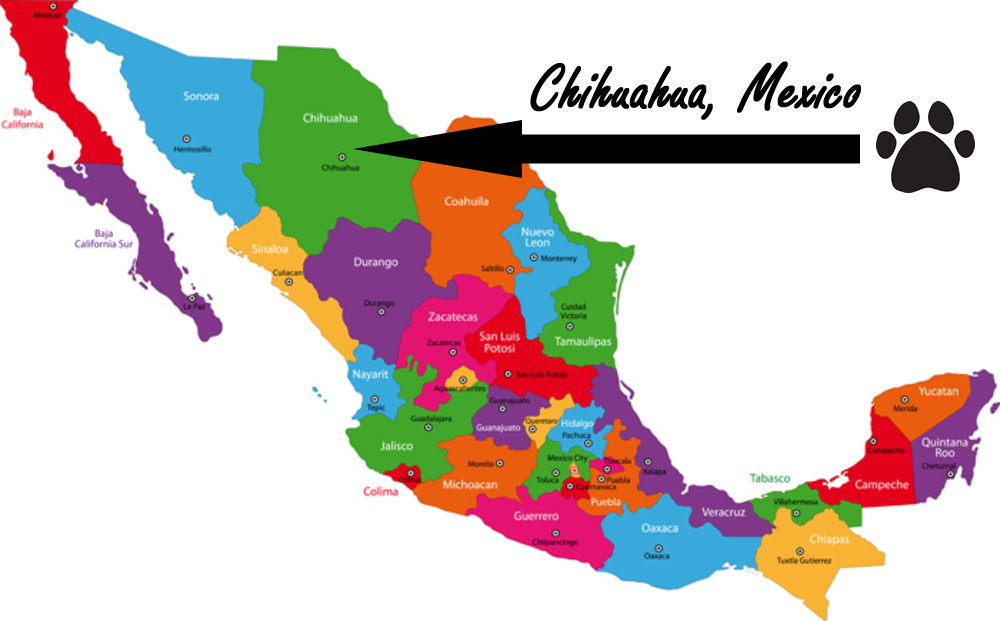
The Techichi Theory
Historians generally accept the idea that some of the earliest Chihuahuas were discovered in Mexico in the late 1800s. It’s what happened before this period that continues to spark debates.
One of the most plausible theories is that the Chihuahua is a descendant of the Techichi, a small-framed companion dog domesticated by several pre-Columbian Mesoamerican civilizations and Native North American tribes. With an average weight of 10 to 20 pounds, the Techichi is roughly twice the size of the Chihuahua but shares many of its counterpart’s physical characteristics. Unlike the Chihuahua, the Techichi is believed to have been mute with only long coats (the Chihuahua has both short and long coats).
Maya and Toltec Civilizations
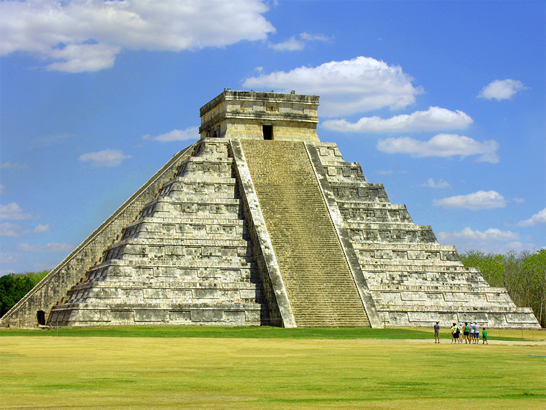
Following this theory, it’s safe to assume either the Maya (1800 BC to 900 AD) or Toltec (900 AD to 1150 AD) were the first to domesticate the Techichi. The Maya — not “Mayan” as some describe this civilization — viewed dogs as being guardians of the afterlife, using them in burial ceremonies and as a source of food. They would often sacrifice, mummify and bury dogs alongside their respective owners, believing their canine companions would join them in the afterlife. The Maya even had nine different words for dog in their language, some of which referred to specific varieties. It’s unknown which breeds the Maya domesticated, but historians believe it included the Techichi and the Xoloitzcuintli (Xolo) at the very least.
When archeologists unearthed ancient burial shafts in Colima, Mexico, they discovered effigy pots and sculptures dating back to 300 BC depicting a dog with striking similarities to the Chihuahua. Archeologists have also discovered wheeled dog toys in Central America dating back to 100 AD, showing both apple head and deer head varieties. These were likely two variations of the Techichi, suggesting a direct link with the modern-day Chihuahua.
Another piece of evidence reinforcing the Techichi theory lies in a 1,200-year-old Maya figurine depicting a woman holding a child in one hand and a small dog with Chihuahua-like characteristics in the other. This figurine can be found at New Orleans’ Tulane University.
The Maya civilization began to decline in 800 AD, giving rise to the Toltec by 900 AD. And like their predecessors, the Toltec also domesticated dogs for food and sacrificial purposes. Archeologists have discovered Toltec carvings of small dogs with rounded apple heads and erect ears, presumably the Techichi.
The Aztec and European Explorers
The Aztec rose to power shortly after the end of the Toltec civilization, establishing their capital of Tenochtitlán in 1325 AD. They viewed the Toltec as being the perfect example of a civilization, following many of their predecessor’s traditions, including both human and dog sacrifices. In an effort to appease their gods, they would sacrifice humans in blood-offering ceremonies. If humans weren’t available, the Aztec would sacrifice dogs, including the Techichi.
Like the Maya, Toltec and other Mesoamerican cultures, the Aztec believed that sacrificial dogs joined their owners in the afterlife. Furthermore, they believed diseases could be transferred from humans to dogs, curing the human in the process.
Several European explorers described the Techichi in written journals. After journeying to the New World in 1529, Franciscan priest and ethnographer Bernardino de Sahagún spent the next 50 years studying the Aztec culture. In his work, Sahagún wrote about the Aztec’s ceremonial practices, which included sacrificing the small dog.
“The deceased were burnt, encircled by all their clothing and belongings, but he who had nothing among his wretched belongings went bare, and underwent much pain and suffered much in order to pass the place of the obsidian-bladed winds. And also they caused him to carry a little dog, a yellow one, and they fixed about its neck a loose cotton cord. It was said that he (the dog) bore the dead one across the place of the nine rivers in the land of the dead.”
The Aztec emphasized color in their culture, viewing yellow as the color of death. According to Sahagún, they would sacrifice yellow-colored Techichis, believing the deceased canines would help them cross the ninefold river to Meitlantecutli. The Spanish conquistador Francisco Hernandez (died 1515) wrote about the Techichi being used as a food source by the Aztec, similar to the way in which Spaniards would eat rabbits.
Other written accounts by European explorers describe how the Aztec domesticated and used the Techichi as pets. In “The Natural and Moral History of the Indies,” Spanish Jesuit missionary José de Acosta (1540 to 1600) described the Aztec, whom were believed to be Indians at the time, feeding dogs and keeping them for company.
“The Indians so love these little dogs that they spare their meat to feed them, so when they travel in the country they carry them upon their shoulders or in their bosoms, and when they are sick they keep them with them but only for company.”
The Techichi, along with their native owners, didn’t fare well following the arrival of European colonizers. Spanish conquistador Hernán Cortés (1485 to 1547) led a third expedition to the New World, which he partly funded using his own money. Cuba’s governor, Diego Velázquez de Cuéllar, attempted to cancel the expedition shortly before the ships sailed. Cortés ignored this order, however, embarking on a bloody conquest that would lead to the fall of the Aztecs while nearly eradicating the Techichi in the process.
Was the Techichi Crossed with Another Small Dog?
While many historians believe the Chihuahua is a descendant of the Techichi, others believe it’s a cross between the Techichi and a small hairless dog known as the Chinese Crested.
If you’re familiar with the World’s Ugliest Dog Competition, you’ve probably heard of this breed before. Held annually in Petaluma, California, it celebrates dogs for their “unique” appearance, rewarding the winning owner with $1,000 and a trophy. All dogs are eligible to participate, but the Chinese Crested continues to dominate the competition, winning year after year.
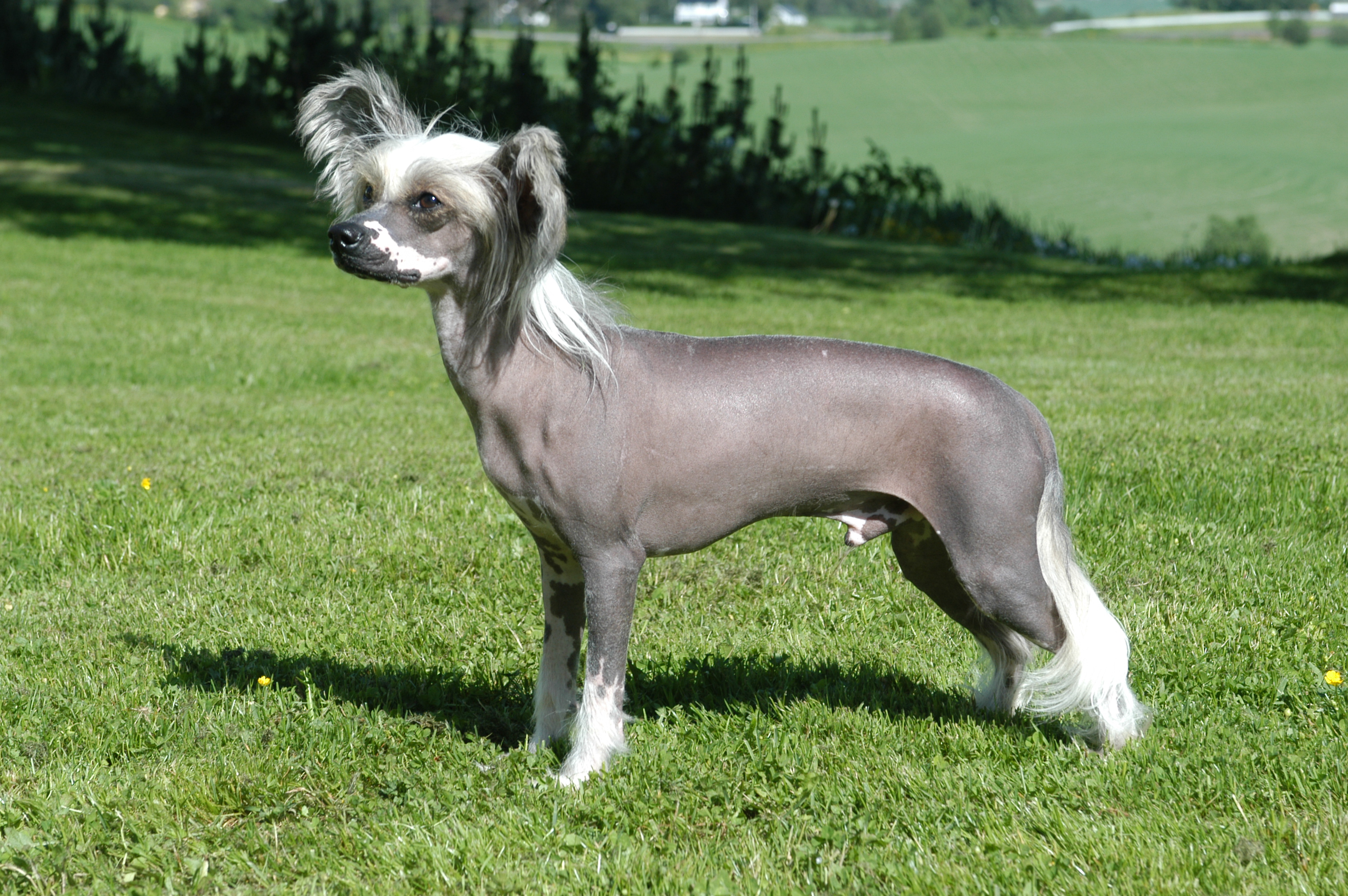
Weighing an average of 10 to 13 pounds (4.5 to 1.4 kg), the Chinese Crested is smaller than many other breeds, albeit larger than the Chihuahua. Some historians believe it was crossed with the Techichi, resulting in the modern-day Chihuahua. Perhaps Chinese explorers or merchants brought the hairless dog to the Americas, but widespread Chinese immigration to Central and North America didn’t occur until the mid-to-late 1800s. If the Chinese didn’t land in the Americas until the 19th century, it would have been impossible for the Chinese Crested to cross with the native Techichi.
Well, several theories suggest China discovered the Americas before Christopher Columbus. If true, maybe some of these early Chinese explorers brought the Chinese Crested to Central America and/or North America, where it was later bred with the Techichi to create the Chihuahua. That’s a long shot to say the least, yet it’s still a possibility historians consider.
Other theories link the Chihuahua to the Xoloitzcuintli (Xolo), a small and mostly hairless dog that has roamed Mexico for thousands of years.
Nonetheless, many historians reject the Chihuahua’s connection to any hairless breed, including the Xolo and Chinese Crested. These hairless breeds have rectangular heads and stiff tails, which is in stark contrast to the Chihuahua’s physical appearance.
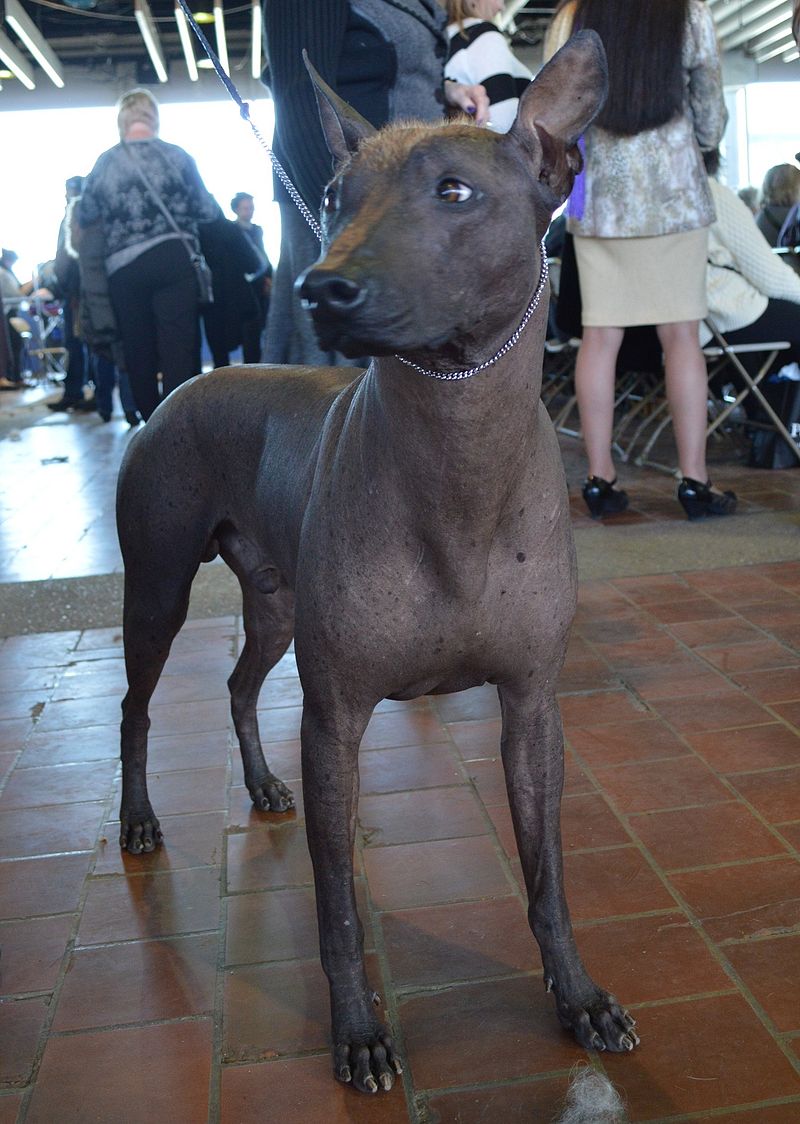
The European Descent Theory
Another possibility is that Chihuahuas originated from Europe, specifically the island country of Malta.
Nestled 50 miles (80 km) below Italy, this Mediterranean island was once home to a small dog, known as the Maltese pocket dog, which shared a distinct characteristic with the Chihuahua: an opening in the skull, also known as a molera or soft spot. Between 80% and 90% of all Chihuahuas are born with this undeveloped cranial gap.
Another piece of evidence connecting the Maltese pocket dog to the modern-day Chihuahua lies in the Sistine Chapel. In 1482, Italian Renaissance painter Sandro Botticelli completed a fresco on the second compartment of the south wall. Known as The Trials and Calling of Moses, this vibrant fresco depicts a boy holding a small dog with an uncanny resemblance to the modern-day Chihuahua.
One could argue that the Maltese pocket dog is actually the Techichi or Xolo brought over from Mexico, but Botticelli completed this fresco ten years before Christopher Columbus discovered the Americas. Therefore, it would have been impossible for him to know what the Techichi looked like.
Below is a photo of Botticelli’s The Trials and Calling of Moses, along with a closeup revealing the boy holding a small dog.
The dog certainly looks like a Chihuahua… What do you think?
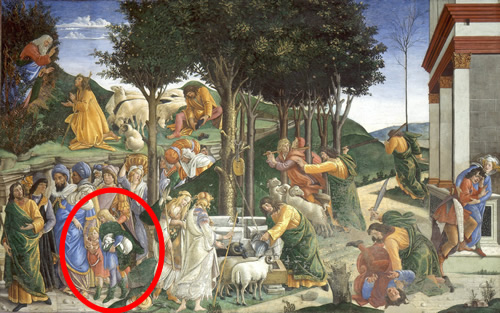
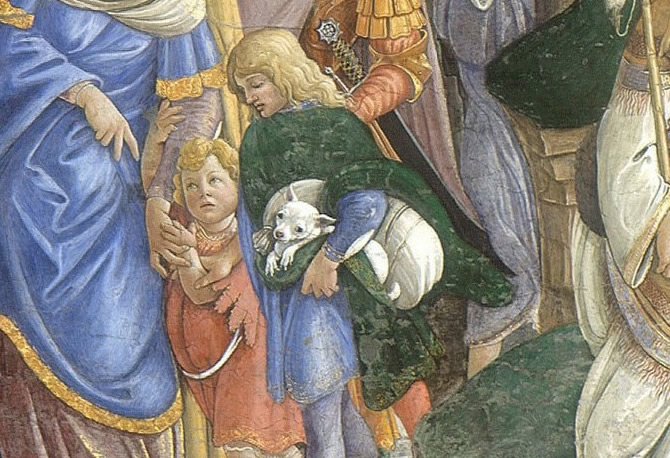
DNA Evidence Sheds Light on Chihuahua’s Origin
A recent study involving the Chihuahua’s DNA may shed light on the breed’s origin. Researchers from the KTH Royal Institute of Technology in Stockholm, Sweden sought to investigate the origins of several modern-day American dog breeds, including the Chihuahua. For the study, researchers compared the Chihuahua’s mitochondrial DNA to Asian dogs, European dogs and archeological sites, looking to see if there was a connection.
Researchers did not find a link between the Chihuahua and any Asian or European dogs. They did, however, discover the Chihuahua’s unique DNA type in Mexican pre-Columbian samples, suggesting the breed — or perhaps its Techichi ancestor — was around in Mexico before the European explorers arrived.
You can access these findings in the Royal Society journal.
The Modern Chihuahua
One of the first detailed written accounts of the Chihuahua was by James Watson, a dog judge and writer who immigrated from Scotland to New York in the 1870s. When traveling to San Fransisco to attend a dog show in 1888, Watson stopped by El Paso and crossed the border into Mexico to investigate rumors of this talked-about breed. Here, he purchased a Chihuahua, whom he later named Manzanita, from a Mexican merchant for $5.
Watson returned soon after to buy several more Chihuahuas, including one of the first champions of the breed, Juarez Bell. He wrote about his new companions in The American Kennel Register and Country Life in America, describing them as being small enough to fit in his pocket.
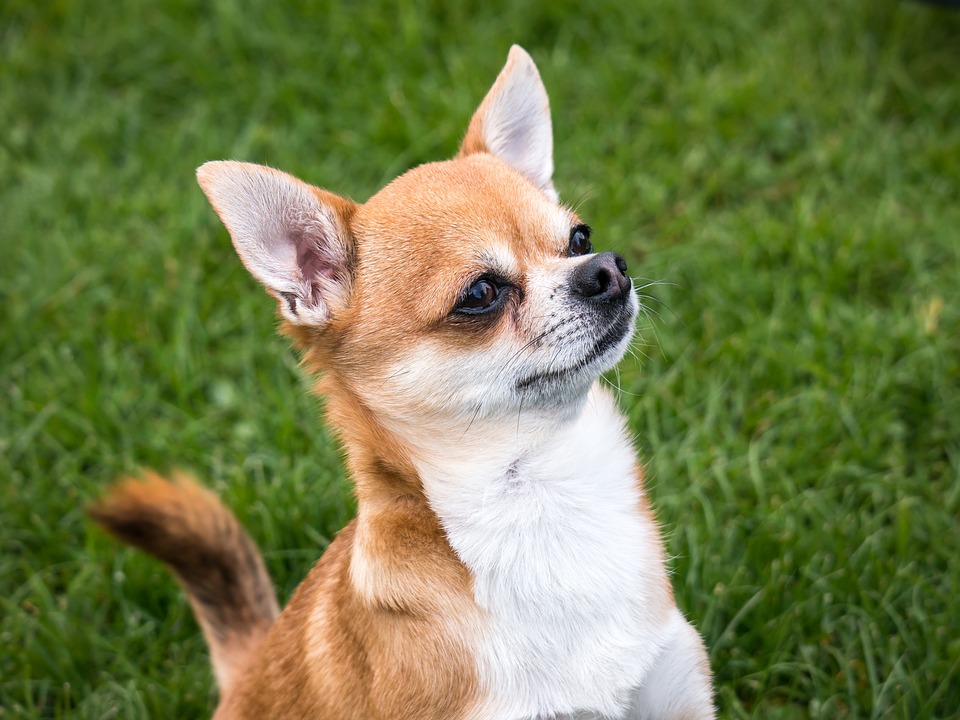
In the 1890s, Mexico’s president gave the famous Italian-French opera singer Adelina Patti a bouquet of flowers in which a small Chihuahua was hidden. Patti felt an immediate connection with her new canine companion, taking Bonito across the country as she toured. At the time, many people had heard of Chihuahuas but never actually seen one. Patti changed the Chihuahua’s course in history by presenting this affectionate, fun-loving breed to the world.
Carl Lumholtz, Norwegian explorer and researcher of indigenous Mexican cultures, wrote about the Chihuahua in his two-volume set Unknown Mexico (1902). According to Lumholtz, the Chihuahua fetched “quite a price” by dog fanciers. He also described the breed as being timid with erect ears, prominent eyes and a small hole on the top of the skull. We did some math to determine exactly how much Chihuahuas cost back then, and after adjusting for inflation, we discovered that James Watson spent the modern-day equivalent of $133.03 for his Manzanita.
It wasn’t until 1904, however, when Texas resident H. Raynor registered the first Chihuahua, Midget, with the AKC. During that same year, three other Chihuahuas were registered with the AKC. And just a few years later, the AKC had its first champion. By 1915, 30 Chihuahuas were registered with the AKC.
The Chihuahua Club of America (CCA) was founded in 1923 to promote the breed and provide educational resources on health, grooming and general characteristics. In 1952, the CCA separated the breed into two different varieties: the smooth coat and long coat.
In 1928, the Canadian Kennel Club (CKC) — Canada’s version of the AKC — added the Chihuahua to its list of officially recognized breeds. In 1948, the United Kennel Club (UKC) — the UK’s version of the AKC — followed suit by adding the Chihuahua to its list as well.
The Chihuahua’s Popularity Grows…
In the early-to-mid 1900s, owners preferred working dogs that could hunt, herd livestock, retrieve fowl and kill varmints. While affectionate and fun-loving, the Chihuahua lacked many of these functional traits. Instead, breeds such as the Collie, Boston Terrier, Beagle and Cocker Spaniel were chosen. This resulted in slow and seemingly stagnant growth for the Chihuahua’s popularity in the U.S.
The public’s perception of dogs began to shift in the 1960s. Rather than owning dogs for work purposes, people sought to own them for companionship — and the Chihuahua was the perfect canine companion. Word quickly spread about this pint-sized dog with a fierce yet loving personality, sparking a newfound popularity for the breed. In 1964, the Chihuahua ranked #12 based on AKC registrations. The AKC even lists the Chihuahua as one of the top 10 breeds of the 1960s. In the 1980s, some 25,000 were registered with the AKC.
In the mid-1990s, the fast food restaurant chain Taco Bell launched an innovative marketing campaign starring a talking Chihuahua named Gidget Chipperton. Voiced by Carlos Alazraqui, Gidget presented the Chihuahua to millions of Americans. So, in addition to increasing revenue and brand recognition for Taco Bell, the commercial campaign played a key role in the Chihuahua’s popularity, particularly in the U.S.
It’s safe to say Taco Bell’s advertising campaign introduced the Chihuahua to millions of Americans. In 1999, the Chihuahua ranked #7 based on AKC registrations. In 2000, it dropped to #8 on the list. In 2001 and 2002, the Chihuahua ranked #9. The Chihuahua’s rankings gradually declined thereafter, dropping to #11 in 2006, and #12 in 2007 and 2008.
In 2012, the Chihuahua ranked #18 based on AKC registrations. With the Chihuahua’s declining rank in AKC registrations, some people assume the breed is no longer popular, but this isn’t necessarily true. At the turn of the 20th century — when the AKC began recognizing the Chihuahua — it didn’t recognize many other breeds. Over the years, the AKC added more than a hundred breeds to its list. As of November 2016, the AKC recognizes 202 breeds. So while the Chihuahua may rank lower today in terms of registrations, this is partially because of the increasing number of recognized breeds.
The Chihuahua has also been popular in the U.K., Canada, Mexico and Australia. In 2008, the Chihuahua (smooth coat) ranked #17 in Canada based on CKC registrations. In 2013, it ranked #4 on the Fédération Cynologique Internationale’s (FCI) list of most registered breeds. In 2015, the Chihuahua (smooth coat) ranked #13 in the U.K. based on the UKC registrations.
Today, the Chihuahua consistently ranks as one of the most popular dog breeds in the U.S., Mexico, U.K., Canada, Australia, and many other countries.
What are your thoughts on the Chihuahua’s history? Let us know in the comments section below!
References:
http://www.britannica.com/EBchecked/topic/585352/Techichi
http://www.akc.org/about/archive/guide-collections/chihuahua-collection/
The Chihuahua (2012) by Susan Payne
Chihuahuas, Complete Pet Owner’s Manual (2013) by Caroline Coile Ph.D
I own a merl lavender. Chihuahuas come in all colors. But the Merl is looked down on due to the Merl Gene. However she is the most beautiful long hair I have ever seen. She has a beautiful coat of white, brown, and blond. I can’t believe that her coat will never allow her to be shown in any ring.
I seem to remember an article in hunting magazine in 1950’s or there about where these dogs were used in large packs to hunt bears in Mexico. The theory being they would annoy bear until Hunter arrived and killing several dogs in the pack was inconsequential due to their numbers. Can any one confirm this ?
I remember seeing an article about them being bred for bed warmers by Mexican royalty can anyone confirm this?
I too have heard and read an article that claimed ranchers putting 20 in burlap sacks with holes for the dogs to see, thrown over the ranchers horse and followed tracks of bear and mountain lions to release and afford the dogs to chase them off . 🤷🏼♀️
I have a pom Chi It’s half Pomeranian a half Chihuahua she’s the best dog I’ve ever had I’ve had Chihuahuas and they are quite good I had a husband that used to beat me and the dog stuck up for me would like him to even near me this dog I have now and the new husband I don’t love of my life it’s like starting a new role life
I have a chugg chihuahua an pug. He is alert well behaved protective and a lover all around one of the best friends I’ve had my last pup was a chihuahua 100% also a good kid thanks for letting me share
Would like to add- the opinions responding to the Piper question r extremely interesting!
Love looking at ALL potential angles
However, those that are of an open minded nature illuminate the endless back and forth potential for discussion
None of us can say, definitively, that our own opinion carries any weight. As anyone who enjoys a friendly, positive debate knows.. the BEST debates are amongst those who r not close minded- but open to all opinions. Bc opinions r something we all have
None of us truly knows the answer.. but the theories have provided a strong desire for delving deeper .. for me.
Great question and great theories!!
I agree! That kid for your word!
There is also a painting called “The Holy Family” by Bartolomé Murillo in which a small dog is depicted and looks very much like a Chihuahua. I believe that the Chihuahua originated on the tiny island nation of Malta!
It said the dogs were DNA tested against European dogs from Malta and Chinese dogs and they share no similarities, but DO share genetic data with precolombian mummy dogs.
My guess is the similarities are a result of parallel evolution, perhaps influenced by people. When two organisms evolve to fill the same niche they can turn out remarkably similar, look it up and you’ll see some interesting examples.
Well i see your point becuase my chi, Dakota is like the fennec fox. Her sandy white fur and her big eyes also her ‘bat’ like ears. She is 13 months old. Maybe the fennec has something to do with its ancestors… Anyway hope your chihuahua/s are ok and you are too! here is a lil chi emoji for u lot
^0•0^ 🙂
I agree, I think the Chihuahua originated from the fennec fox. Surely it couldn’t come from a wolf as all dogs apparently originate from, there surely would be too much of a size difference there but the similarities with the fennec fox are spot on
I have a 10 pound 3 1/2 year old chi named Precious. She lives up to her name. She loves me as much as I love her. Smart as a whip and always by my side.
My golden deer head Chihuahua Honey is truly a sweet dog, and she fits the deer head description to a T. It’s interesting to know she has a pedigree that goes back possibly thousands of years in North and Meso-America.
My chihuahua aptly named Chiwa-wa is the most loyal and entertaining dog I have ever had. She knows no fear and seems to understand my every word she truly is this mans best friend.
My chi is 9 years old. He is a smooth coat blonde apple head. My daughter had hers & I fell in love. He is from Ensenada Mexico. I have had several dogs but never one this loyal, protective, & intelligent! He is truly the love of my life. His name is bandit.
I read your comment and just Had to respond! My little boy will be 3 this year! His name is Also Bandit! 😊 He got his name because he is a tri-color and one of the colors is black, it’s Only on his little face and looked just like a little mask. It has spread some over the years, but it’s still the only place that has any significant amount of black. He is so well mannered and quiet and has helped to change many “little dog haters'” minds about his breed. My little ambassador lol
John Correll I have the little dog and I call him Moe and he is the best friend I have ever had he love to Ride in my simi truck and we go all over the US and when he pass on I well have lost my best friend..
John Correll
My apple head is named cha-cha( like the dance) and although he was born with hydrocephalus he is smart and fun loving. He has some neurological tics, but it must have been a lite case because he doesn’t have seizures. I enjoyed reading the history of this breed and the theories of conception.
In a restaurant I saw a picture of a woman resembling what appears to be a large chihuahua. The picture was in black and white. Does anyone know what type of dog it is?
Dear Piper’s astute / intuitive owner,
My beloved daughter, now deceased at the tender age of 33..obtained her first nursing position in AZ. Newly graduated nurses.. even BSRN’s with brilliance, find landing a job difficult. All medical institutions desire seasoned nurses.. doing themselves & patients a great disservice.. topic for another day. So, she left her beloved family home.. relocated to AZ. Being a closer than close knit family- she discovered an actual suitable, if not better companion in the chiwauau breed. Initially, drawn in by the Paris Hilton phenomenon.. she made the sad mistake of purchasing a “ toy” breed. As we who r educated in this cruel breeding process know- the “tea cup” or “toy” breeds are NOT to be sought after. They r a result of breeding the smallest in the litter.. with another of same diminutive attributes. Creating a dog with weak constitution- abnormal for the true breed. Her beloved Bandit, with the dark markings, breathed his last breath, while in her arms on day 3. She attempted mouth to mouth. Calling me sobbing, I was extremely compassionate being one who recognizes dogs as one of our greatest gifts. To this day, I have Bandits paw print imprinted on hardened clay. Not to be deterred, she went on the hunt- found a litter of a friend. She chose the LARGEST after losing Bandit. Now, suppose you made it your business to continually breed the largest chi with same, generation after generation?
This most likely would result in a much larger version of the original. She named him Angel. True to his name, he was at her side always, esp close whenever she was ill.. as a living heating bottle; refusing to leave her to eat, drink or relieve himself until she was well. This included the night she passed. Being the most loyal animal in my experience; i assumed he would perish. She was his one and only. Personally, I despised the dog as his shrill barking, should anyone enter his mommy’s home ( my home!) penetrated my ear drums daily. After she passed.. tried to give him to a loving home w no success. As I grieved, my Angel lay w me .. licking each tear as they streamed down my face. He too was suffering more than anybody w the exception of me. He put aside his pain to tend to me. He became lame, very ill, gained 10 lbs due to inactivity and cortisol, the stress hormone. Within 2 yrs time; we nursed each other back to health and have formed a well defined pack. Grammy, husband Poppy, my sons dog, Kailey (they were arch enemies out of jealousy prior. They both wanted my daughter as mommy.)
Angel had dibs, and would attack this large dog.. a mutt, frequently.. suffering life threatening wounds as the mutt.. is half Pitt . A beauty in her own right, inside and out however, now accepts Angel as THE BOSS. They r best friends and Angel calls the shots. We have Settled into a pack, all 4 of us had to give, give, give , to achieve this, harmonious state
Angel & I have both healed quite well. His lameness and I’ll state began. After he lost his true love.. my daughter. Leading me to agree theoretically with the society that believed these ANGELS absorb the grief and illness of their owners. Angel swapped out daughter for me immediately. Always known as the twins.. she and I were like 2 halves of a whole. Angel KNEW of this connection. He grieved so pitifully itvwould have made a grown man cry.. but hung in there for me
Tipping the scales at 25.. natural weight falls at about 15 lbs; based above all factors – my personal experience and much unbiased research on Chi’s.. my intuition and logic determine – that ( LARGE) Chi you saw .. was JUST THAT.. a large Chi. My Angel shares ALL typical personality traits as a smaller Chi.. as well as physical.. just larger! Ppl have never concluded that he is a mix. The vet confirmed this dog is a Chi. No if ands or buts about it.
My Angel and I, saved each other. His role the mightiest. I would give him my last bit of food if tested, and starve.
My Angel is TRULY AN ANGEL.
Always had Labs. Greatest large dogs in my experience..NEVER thought I would own a diminutive breed.
Intend to have a Chi til my last breath. Labs r wonderful to run , take swimming, spending hours a day throwing sticks out in the water for retrieval. However, at the age of 60; having a Chi, means never having to take for a run when I’m ill.. he prefers outdoors, but Is pad trained for those times I can’t get out.
Having despised the breed, doing a 180•, would NEVER be without.
Thank you for posing the question- my opportunity to put down in words; my miracle Angel 🧚🏻♀️
I bought my mom a chihuahua as I had to put her dog down because we both hated to see her suffer. I bought the cheapest puppy I could find online. Long story short, mom died and I cried, and this dang dog would cry with me. Now I’m so afraid of losing her, that I obsess over where she is at, if she has food I her bowl and fresh water, etc. It’s like having a baby and yes being a single dad is hard, but if it wasn’t for her I’d be dead from a broken heart.
RIP, my mom, I’m the only kid whom had a mom that was named “my mom.”
Why has nobody made the possible connection to the wild Fennec fox,native to North Africa ?
The similarities between this & the Chihuahua or Techichi are quite
obvious.
I think the fennec fox connection is only in appearance, as the Chihuahua is genetically descended from the prehistoric predecessor of the grey wolf just like all other domestic dogs. The large ears are an adaptation to control body temperature in warm climates…
I agree with you Steven! I think the Fennec fox is part of the Chihuahua line. The similarities are just to much to ignore!
It’s not genetically possible for a dog to decend from a fox in modern history, they split common ancestors a long long time ago. But they certainly do look similar.
I love chihuahuas i knew that their was something about my dog that was special and now everyone else knows my dog is very special to me love chihuahuas
Nonsense! Look at the painting again. The boy is holding a puppy. Chihuahuas are of New World origin.
My best guess is that this Sandro Botticelli was either a time travelling facile facilitator of fantastically frenzied frescos or, and this is a big OR…Sandro Botticelli was a master psychic (on par with the late great Sylvia Brown, I would imagine), knowledge of which was never spoken of, adding to the long list of Illumanati secret sealed away, and thus hidden from the world, ever since this particular glimpse into the secret history of this particular canine breed. There can be no other explanation for the oddity in which these two events relate to each other after so many years.
That response made me laugh. Very well written!